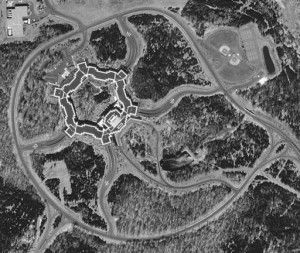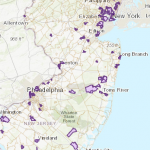New Jersey Future Blog
Memo to Municipalities: Get Creative and Flexible if You Want Those Office Parks Redeveloped
July 19th, 2013 by Elaine Clisham
“[Millennials] are a tech-savvy generation wanting to live in higher-density activity environments, and they do not find one-dimensional office campuses particularly attractive.”
 So said James Hughes, dean of the Bloustein School of Planning and Public Policy at Rutgers University, during his presentation at a July 12 conference on Reinventing New Jersey’s Obsolete Suburban Office Campus. The conference, hosted by the New Jersey State League of Municipalities Educational Foundation, brought together policy makers, planners, commercial real estate developers and local officials to consider how such facilities might be re-imagined for a new economic environment.
So said James Hughes, dean of the Bloustein School of Planning and Public Policy at Rutgers University, during his presentation at a July 12 conference on Reinventing New Jersey’s Obsolete Suburban Office Campus. The conference, hosted by the New Jersey State League of Municipalities Educational Foundation, brought together policy makers, planners, commercial real estate developers and local officials to consider how such facilities might be re-imagined for a new economic environment.
Dean Hughes set the stage by presenting an overview of how New Jersey came to be a specialist in suburban office corridors. He then reviewed both the technological disruptions and the market forces that have combined to create long-term structural changes in the state’s overall office market: most facilities were built during the 1980s and 1990s, and their infrastructure, particularly their technological infrastructure, is now obsolete; technology is allowing workers to be much more mobile and to need less, and less formal office space; and the advent of Millennial workers with different workplace preferences is pushing employers toward more urban environments with multiple amenities and good transit connectivity. The result? New Jersey’s suburban office stock is out of date, “over-supplied and under-demolished,” Hughes said.
Five-Year Window of Opportunity
And yet these suburban office facilities come with upgraded, sometimes state-of-the-art infrastructure, and they represent to their host municipalities a significant source of property tax revenue. Former state Secretary of Commerce Gil Medina, now with the real estate firm CBRE Group, who spoke next, highlighted an emerging counter-trend among the investment community: a growing move to rescue these “stranded assets” and turn them into opportunities. However, he said, this will take a while. Real estate is regarded as a lagging indicator to job growth, he said, and he sees a five-year window during which these properties can be re-imagined. He stressed that it will require creativity on the part of developers and flexibility on the part of the host municipalities.
Some real estate developers are already working on reformulating suburban office parks. The next panel allowed several of them to show their work, from modernizing a World War II-era facility for a German pharmaceutical company to repurposing an old manufacturing facility as luxury residential loft rentals to staging a one-night “pop-up town center” to show nearby residents how a large corporate facility could be transformed.
Challenges Going Forward
The final panel addressed the challenges going forward of trying to re-envision suburban office parks. Michael McGuinness, the chief executive officer of NAIOP’s New Jersey chapter, urged municipal officials to do all they could to facilitate the development of work environments that cater to Millennials. Leading developers are already taking their preferences into account, he said, and “not to do so represents a huge threat” that this cohort will decide to leave New Jersey.
Among NAIOP’s recommendations is to pay much more attention to infrastructure funding, especially transportation as well as water and power. He mentioned in particular pending legislation that would expand the power of the state’s Environmental Infrastructure Trust to include transportation and power, allowing municipalities additional opportunities to finance upgrades to those systems. Finally, he said, NAIOP is working on measures to allow owners of older commercial facilities access to programs that would allow them to upgrade those buildings’ energy efficiency.
Attract the Right Workforce
Richard F.X. Johnson, senior vice president of Matrix Development Group, re-emphasized the critical role of mass transit in attracting younger workers and in getting more challenging projects done. He observed that “the corporate location decision model has completely changed,” and is now focused not on creating a corporate statement or on the return on a developer’s investment, but on how well a location can recruit an employer’s desired workforce. He made the point that the occupancy cost of space – the number of workers multiplied by their salaries divided by the square footage they will occupy – is far higher than the rent and expense costs of the space, creating a big incentive to attract the best talent. He stressed that community design and zoning flexibility will be key to municipalities’ ability to attract employers, and developers will look for mixed-use zoning and the ability to phase development as simply the price of entry.
Johnson referred to a phenomenon that has come to be known as “peak car.” Millennials, he said, are driving far less than their parents and grandparents did. “Unlocking” mass transit to some of these suburban sites will add value, he said, and value will spur density, which in turn will bring greater value to municipalities. He recommended reducing parking minimums, both to reduce the costs of building parking and to increase opportunity for value-boosting density. And he urged both developers and municipalities to have the courage to consider innovative strategies, including adoption of such tools as public-private partnerships, tax-increment financing and transportation development districts, in order to help finance the kind of transportation improvements these sites will require if they are to remain viable. Quoting former state DOT chairman Jack Lettiere, he said that “transportation is the game board on which the entire economy is based.”
Municipal Resistance Will Hurt New Jersey
Joseph Maraziti spoke next, addressing the issue from his twin perspectives as both a redevelopment attorney and a former chairman of the state Planning Commission. His concern, he said, is about the more difficult projects and the municipalities that might be less flexible in their zoning. There is plenty of municipal resistance, he said, to the idea of converting a “clean ratable” that doesn’t consume a lot of public services into a mixed-use site, and he cited in particular the resistance to creating housing for families with school-age children. He warned that municipalities that try to keep schoolchildren out are in for long-term trouble when those schoolchildren grow up and move to more welcoming, and more urban, environments. (A follow-up question from the audience about how to address municipalities’ preference for anti-family zoning elicited the suggestion that municipalities need to look at what is very likely to be extra capacity in their school systems, suggesting that allowing multi-family housing that brings with it additional schoolchildren will not bring a lot of additional school costs and will help the town by spreading the property-tax burden across a higher residential density.)
Maraziti fears that municipal resistance to redeveloping these more challenging sites will leave those sites completely idle, which he sees as a problem for the state: As the quantity of developable land decreases and the state’s population increases, the need for sites like these will increase since they will represent the only viable growth areas. He recommends that municipalities go through the difficult task of re-examining their zoning ordinances to ensure that they encourage creative re-use of such sites – re-use, he says, in ways that citizens haven’t yet been able to imagine or understand.
How One Township Got It Done
Last to speak was Ronald Francioli, mayor of Hanover Township, who talked about the steps Hanover has taken to encourage adaptive redevelopment of its office sites. It is critical, he said, that municipalities address what he called “municipal culture,” including forcing developers to go through a difficult and arcane approval process. Losing a major commercial ratable, he said, shook up his township. In response, the township formed an Economic Development Advisory Council; as mayor he brought all his department heads together to look at the problem honestly; to examine the development process with a business focus and to streamline it to make it easier; and to establish mechanisms for better inter-board cooperation. The township’s ECAC now shadows a development application through the entire process to help smooth any hurdles. The township is now going through its master plan re-examination and is inviting draft submissions from the development community for updates to both the plan and the township’s zoning ordinance.
Losing a major ratable, he said, has ripple effects throughout the township, including higher taxes imposed elsewhere and increasing numbers of tax appeals, as well as the loss of ancillary businesses. He stressed that communities will still need state incentives in order to retain employers, and he urged that these incentives be expanded to cover leasing tenants as well as building owners. Overall, he said, there needs to be a more lenient approach to redevelopment and reinvention.
Saved for the question-and-answer session was a discussion about regional context, in terms of both connecting individual sites to surrounding areas and addressing these planning issues not on a municipal scale but on a regional scale. A regional approach will be important, participants and panelists said, if New Jersey is going to weather the difficult period of reinvention of its struggling suburban office parks.
What About Properties in Difficult Locations?
Not discussed, but an equally important question is whether some of these corporate campuses are so poorly located based on New Jersey’s future community, economic and environmental goals that a more radical re-thinking may be necessary – including abandoning for the foreseeable future the idea of redeveloping these sites at all. Whatever the answer, it is clear that each site will need to be evaluated on its own merits and a flexible repurposing plan developed within a larger regional context.
















